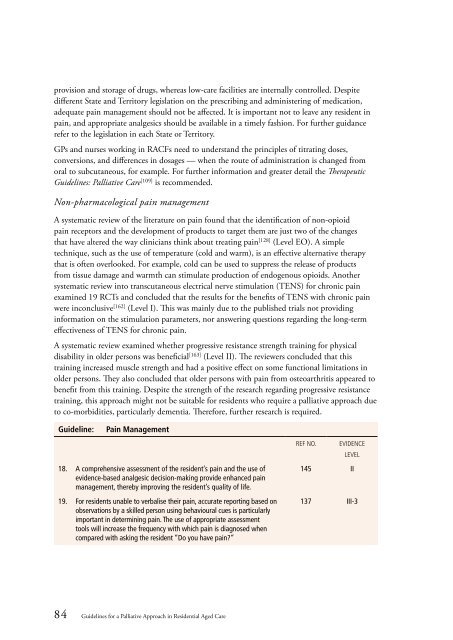Guidelines for a Palliative Approach in Residential Aged Care
Guidelines for a Palliative Approach in Residential Aged Care
Guidelines for a Palliative Approach in Residential Aged Care
Create successful ePaper yourself
Turn your PDF publications into a flip-book with our unique Google optimized e-Paper software.
provision and storage of drugs, whereas low-care facilities are <strong>in</strong>ternally controlled. Despite<br />
different State and Territory legislation on the prescrib<strong>in</strong>g and adm<strong>in</strong>ister<strong>in</strong>g of medication,<br />
adequate pa<strong>in</strong> management should not be affected. It is important not to leave any resident <strong>in</strong><br />
pa<strong>in</strong>, and appropriate analgesics should be available <strong>in</strong> a timely fashion. For further guidance<br />
refer to the legislation <strong>in</strong> each State or Territory.<br />
GPs and nurses work<strong>in</strong>g <strong>in</strong> RACFs need to understand the pr<strong>in</strong>ciples of titrat<strong>in</strong>g doses,<br />
conversions, and differences <strong>in</strong> dosages — when the route of adm<strong>in</strong>istration is changed from<br />
oral to subcutaneous, <strong>for</strong> example. For further <strong>in</strong><strong>for</strong>mation and greater detail the Therapeutic<br />
<strong>Guidel<strong>in</strong>es</strong>: <strong>Palliative</strong> <strong>Care</strong> [109] is recommended.<br />
Non-pharmacological pa<strong>in</strong> management<br />
A systematic review of the literature on pa<strong>in</strong> found that the identification of non-opioid<br />
pa<strong>in</strong> receptors and the development of products to target them are just two of the changes<br />
that have altered the way cl<strong>in</strong>icians th<strong>in</strong>k about treat<strong>in</strong>g pa<strong>in</strong> [128] (Level EO). A simple<br />
technique, such as the use of temperature (cold and warm), is an effective alternative therapy<br />
that is often overlooked. For example, cold can be used to suppress the release of products<br />
from tissue damage and warmth can stimulate production of endogenous opioids. Another<br />
systematic review <strong>in</strong>to transcutaneous electrical nerve stimulation (TENS) <strong>for</strong> chronic pa<strong>in</strong><br />
exam<strong>in</strong>ed 19 RCTs and concluded that the results <strong>for</strong> the benefits of TENS with chronic pa<strong>in</strong><br />
were <strong>in</strong>conclusive [162] (Level I). This was ma<strong>in</strong>ly due to the published trials not provid<strong>in</strong>g<br />
<strong>in</strong><strong>for</strong>mation on the stimulation parameters, nor answer<strong>in</strong>g questions regard<strong>in</strong>g the long-term<br />
effectiveness of TENS <strong>for</strong> chronic pa<strong>in</strong>.<br />
A systematic review exam<strong>in</strong>ed whether progressive resistance strength tra<strong>in</strong><strong>in</strong>g <strong>for</strong> physical<br />
disability <strong>in</strong> older persons was beneficial [163] (Level II). The reviewers concluded that this<br />
tra<strong>in</strong><strong>in</strong>g <strong>in</strong>creased muscle strength and had a positive effect on some functional limitations <strong>in</strong><br />
older persons. They also concluded that older persons with pa<strong>in</strong> from osteoarthritis appeared to<br />
benefit from this tra<strong>in</strong><strong>in</strong>g. Despite the strength of the research regard<strong>in</strong>g progressive resistance<br />
tra<strong>in</strong><strong>in</strong>g, this approach might not be suitable <strong>for</strong> residents who require a palliative approach due<br />
to co-morbidities, particularly dementia. There<strong>for</strong>e, further research is required.<br />
Guidel<strong>in</strong>e:<br />
Pa<strong>in</strong> Management<br />
18. A comprehensive assessment of the resident’s pa<strong>in</strong> and the use of<br />
evidence-based analgesic decision-mak<strong>in</strong>g provide enhanced pa<strong>in</strong><br />
management, thereby improv<strong>in</strong>g the resident’s quality of life.<br />
19. For residents unable to verbalise their pa<strong>in</strong>, accurate report<strong>in</strong>g based on<br />
observations by a skilled person us<strong>in</strong>g behavioural cues is particularly<br />
important <strong>in</strong> determ<strong>in</strong><strong>in</strong>g pa<strong>in</strong>. The use of appropriate assessment<br />
tools will <strong>in</strong>crease the frequency with which pa<strong>in</strong> is diagnosed when<br />
compared with ask<strong>in</strong>g the resident “Do you have pa<strong>in</strong>?”<br />
Ref No. Evidence<br />
level<br />
145 II<br />
137 III-3<br />
84 <strong>Guidel<strong>in</strong>es</strong> <strong>for</strong> a <strong>Palliative</strong> <strong>Approach</strong> <strong>in</strong> <strong>Residential</strong> <strong>Aged</strong> <strong>Care</strong>
















